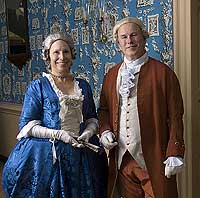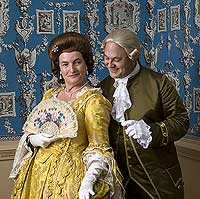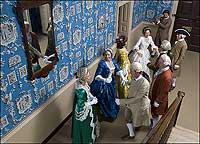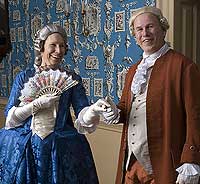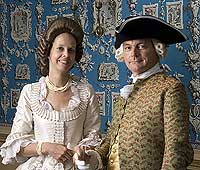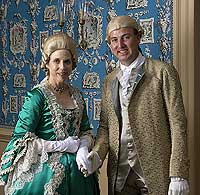Once Around the Colonial Seasons
by Anthoni Aveni
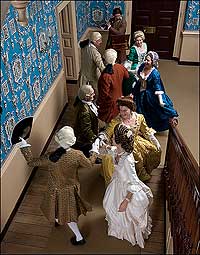
A dance to celebrate Twelfth Night. From the top, the ladies are Karen Schlicht, Merry Feyock, Diana Freedman, and Barbara Tyler Mullins; the gentlemen Andrew DeLisle, Chris Lanier, Dale Riley, Merritt Capossela, and Stephen Moore, all of Colonial Williamsburg.
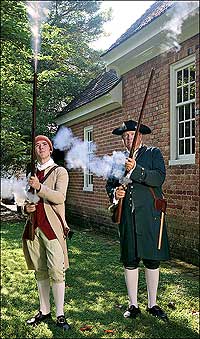
A visiting Frenchman was recalled from sleep by the blast of muskets firing outside his window, a noisy New Year's tradition in the colonies. John Sid, left, and Ken Briner of Colonial Williamsburg are the troublemakers.
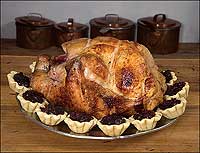
Food marks seasonal celebrations, and at Thanksgiving and Christmas, turkey, with cranberry tarts, usually runs neck and giblet with ham as the main dish.
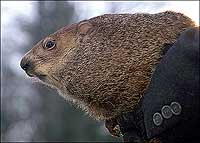
Punxsutawney Phil, the oracular groundhog, was the closest Pennsylvanians could come to the hibernating badger Germans had traditionally appointed their midwinter mascot. The English preferred the hedgehog, the Basques the bear.
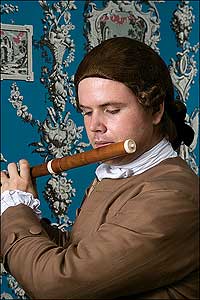
Colonial Williamsburg's Andrew DeLisle tootles a wooden flute to keep the dancers turning to the tunes during holiday season.
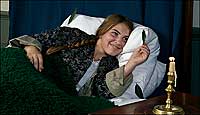
Bay leaves pinned to her pillow promised a girl, here Laura Horsting, her choice of St. Valentine's beau.
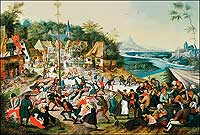
Pieter Brueghel the Younger painted a Maypole dance, the guests in front clearly having visited the refreshment stand too often.
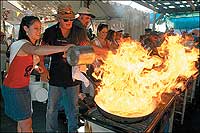
Harvest festivals start in summer and run into the fall. In Gilroy, California, a calamari flame-up warms the annual garlic festival.
Sunday, January 7th, 1775. Last night I went to the Ball. It seems this is one of their annual Balls supported in the following manner: A large rich cake is provided and cut into small pieces and handed round to the company, who at the same time draws a ticket out of a Hat with something merry wrote on it. He that draws the King has the Honor of treating the company with a Ball the next year, which generally costs him Six or Seven Pounds. The Lady that draws the Queen has the trouble of making the Cake. Here was about 37 ladies dressed and powdered to the life, some of them very handsome and as much vanity as is necessary.
So reads an entry in the diary of Nicholas Cresswell, a British visitor to colonial Virginia. The occasion was the biggest event of the Christmas season and of the seasonal year—the Twelfth Night Ball. Christmas itself in the Old Dominion was no big deal: there was church, dinner—the American turkey had already replaced the traditional English roast beef—afternoon visitations, a display of greenery, games, a fox hunt, and other entertainment sprinkled about the two-week season. "None was meant for kids, and the youngsters were cordially not invited to attend," wrote Colonial Williamsburg historian Emma Powers.
On occasion, Twelfth Night Balls could become raucous. Cresswell said:
Betwixt the Country dances they have what I call everlasting jigs. A couple gets up and begins to dance a jig (to some Negro tune) others comes and cuts them out, and these dances always last as long as the Fiddler can play. This is sociable, but I think it looks more like a Bacchanalian dance than one in a polite assembly. Old Women, Young Wives with young children in the lap, widows, maids and girls come promiscuously to these assemblies which generally continue till morning. A cold supper, Punch, Wines, Coffee and Chocolate, but no Tea. This is a forbidden herb. The men chiefly Scotch and Irish. I went home about two o'clock, but part of the company stayed, got drunk and had a fight.
Reciprocal generosity has always attended the turning of the seasons, from the time of the ancient Roman Saturnalia, when generous gift giving to household members accompanied a reversal of roles. Master attended slave, and the village idiot was coronated mock king-for-a-day. On Plough Monday, which followed Twelfth Day in England and the colonies, boys dressed as clowns and paraded a decorated plow from village to village extracting alms by teasing and mildly insulting spectators—including town officials. Adding to the emotional anarchy, mumming, or masking—parading and dancing among townsfolk who would try to guess the identity of the person behind the face—was another tradition transplanted from Europe. Nevertheless, as might be expected, one's temporary loss of identity can give rise to erratic behavior.
A French visitor to the New York colony recounts a New Year's Eve in which groups of youngsters, servants, and slaves invaded the household in expectation of the annual handout:
I had traveled far enough in the day to hope for a quiet sleep, but, at four in the morning, I was awakened by a musquet fired close to my windows...I again attempted to go to sleep, but a quarter of a hour after a fresh musquet or pistol shot interrupted my repose; this was followed by several others. . . . at the end of half an hour, I heard a confused noise of upwards of a hundred persons, chiefly children or young people, assembled under my windows, and I very soon had farther indication of their proximity, for they fired several musquet shot, knocked rudely at the door, and threw stones against my windows. Cold and indolence still kept me in bed, but Mr. Lynch got up and came into my chamber to tell me that these people certainly meant to do me honour, and get some money from me. I desired him to step down and give them two Louis; he found them already masters of the house and drinking my landlord's rum. In a quarter of an hour, they went off to visit other streets, and continued their noise till daylight.
What seems abnormal behavior to us is a way of validating our place in society and bonding formal relationships with those who share with us the social stage. The office party at the end of the year is one of today's mechanisms for strengthening social equilibrium in a hierarchical society. Then, employer and employee gather and mingle on common turf; they chat together, eat together, and party together as social equals.
The word "season" means "time due." Ever since we began to hunt game and build shelters we have celebrated the seasonal round with its special days—when the salmon begin to run, when the rains commence, when the berries ripen, when the reindeer migrate, and so on. Knowing your due was the key to survival. And when stressful anticipation of the catch or kill ended in success, it was time to celebrate. Because a tide of consumerism submerges the meaning of our holidays, we forget that our ancestors took such occasions to venerate the powers of nature in the form of deities. We called them "holy days," and when we celebrated them depended on our needs, which of course have changed through time. Many of our civic holidays, such as Armistice Day, Independence Day, Mother's Day, had no counterpart in the colonies. Moreover, the ethnic heritage of the original thirteen was varied. The colonial calendar scarcely resembles that of the twenty-first-century nation.
More important than the days that mark the beginnings of the seasons—winter, spring, summer, and autumn—were those that indicated their midpoints, the so-called Cross Quarter days of the old Celtic calendar. Their vestiges were still recognizable in colonial times.
Called Dimelc, February 1–2 marked the middle of the winter. It was a curious mixture of animal worship and recognition of the fertility due us for enduring a harsh winter.
In the cult classic film Groundhog Day, skeptical television weatherman Bill Murray lusts after Andie MacDowell. Only through repeatedly reexperiencing the dubious holiday in rapid-fire succession does he achieve decorous success. How many times must we observe our own holidays before we discover their meaning? But there is a subplot to the script: the confrontation between science and magic, the Weather Channel technology for meteorological prognostication and old tales about weather prediction that come from the observation of nature, sprinkled with folk wisdom and more familiar to the colonists: "When ducks are driving through the barn, that night weather takes a turn." "When swallows fly low, expect storm or cold."
What is the psychology behind worshiping a lowly and relatively lazy critter like the groundhog? Humans have always envied hibernating animals, for they possess the built-in savvy to stay put instead of fleeing to Florida. They avoid our heating bills and our complaints about the way winter exacerbates their aches and pains by curling up in a burrow and entering into stuporous slumber. Thus Basques lauded the bear, English the hedgehog, and Germans the badger. Pennsylvanians chose the closest creature they could find to the badger. Biologists who have weighed the testes and taken the anal temperature of hibernating groundhogs—don't ask me how—certify that the male groundhog's interest in his own shadow is eclipsed by the biological clock which motivates him, like us, to seek his due in the form of a female counterpart.
Candlemas, February 1, is the Christian inheritor of the pagan custom of such midwinter weather prognostication: "If it neither rains nor snows on Candlemas Day, you may straddle your horse and go to buy hay." "If Candlemas is bright and clear, there'll be two winters in the year." When the Roman Empire established the church, this holiday celebrated the purification of the mother of Christ in the temple forty days after his birth. Candles were lit at the beginning of each month of purification, when a general cleansing took place in preparation for a new start in the coming spring.
Valentine's Day follows close by in the month of purification—Februa in Latin. The Roman version of this holiday was Lupercalia, after the shewolf that nurtured Romulus and Remus, the legendary founders of the empire. On this day, boys proceeded to the grotto of Lupercal to sacrifice goats. They dressed up in the goat skins, and armed with strips cut from them, chased young virgins around Palatine Hill, laughing loudly and gently whipping them with the strips to drive away the feminine barrenness that accompanies the dead of winter. The laughter was supposed to scare off evil spirits that might seek to impede the result.
Far from celebrating the fecund powers of wild men, colonial Valentine's Day descends from the name of a saint who performed marriage ceremonies rendered illegal by the third century a.d. Roman emperor Claudius II, "the Cruel." He outlawed marriage because too many able-bodied warriors had been tying the knot to avoid the draft. Our benign Valentines and boxes of chocolates—contrary to popular belief, chocolate is not an aphrodisiac—are a far cry from the love-inducing magic practiced in ancient Rome, which survived in colonial America. For example, The Connoisseur of 1754 reports this bit of Valentine love magic:
Last Friday was St. Valentine's Day, and the night before I got five bay leaves and pinned four on the corners of my pillow, and the fifth to the middle; and then if I dreamt of my sweetheart, Betty said we should be married before the year was out. But to make it more sure I boiled an egg hard and took out the yolk and filled it with salt; and when I went to bed ate it shell and all without speaking or drinking after it.Colonial women wrote their lovers' names on bits of paper, rolled them in clay, and put them into a vessel of water; the first that rose to the top was their valentine.
Another custom had it that the first person you lay eyes on Valentine's morning becomes your spouse. As a love-smitten lass wrote: "Would you think it? Mr. Blossom was my man. I lay abed and shut my eyes all the morning, till he came to our house, for I would not have seen another man before him for all the world."
Though it ended the sacred portion of the year that began with the Advent, Easter was not widely observed. Dutch settlers colored eggs with the juice of spinach, beet, and tree bark, but there was no Easter bunny or basket of goodies. Nevertheless, Ancient Beltane, or May Day, the second of the quarter-year days, was celebrated. Villagers went "a-maying," gathering flowers and greenery and decorating and parading in song and dance around a Maypole. Some indulged in the New Year habit of firing guns. This early description of a celebration from 1628 offers insight into the spirit of the day. Inhabitants of Pasonagessit, or Ma-re Mount, Massachusetts,
did devise amongst themselves to have it performed in a solemn manner with Revels, & merriment after the old English custome: prepared to sett up a Maypole upon the festall day of Philip and Jacob; & therefore brewed a barrell of excellent beare, & provided a case of bottles to be spent, with other good cheare, for all commers of that day. And because they would have it in a compleat forme, they had prepared a song fitting to the time and present occasion. And upon May Day they brought the May-pole to the place appointed, with drumes, gunnes, pistols, and other fitting instruments, for that purpose; and there erected it with the help of Salvages, that came thether of purpose to see the manner of our Revels. A goodly pine tree of 80. foote long, was reared up with a peare of buckshorns nayled one, somewhat neare unto the top of it: there it stood as a faire sea marke for directions; how to find out the way to mine Hoste of Ma-re Mount.And because it should more fully appeare to what end it was placed there, they had a poem in readines made, which was fixed to the Maypole, to shew the new name confirmed upon that plantation, which although it were made according to the occurrents of the time, it being Enigmattically composed pusselled the Seperatists most pittifully to expound it.
Horrified by the spectacle, Thomas Morton termed the Maypole a phallic idol—the "Calf of Horeb." He ordered it torn down and the custom of maying outlawed. Still, young men sang a song to the pole hoping that wives would be "brought over" for them, "for it would save them a laboure to make a voyage to fetch" them.
The pole probably descends from ancient tree worship. Believers proffer a link between the human and divine worlds in the form of a tree, which became the repository of nature's fertile powers. We still knock on wood to bring good luck.
Our Thanksgiving comes at the end of a long, and hopefully successful, growing season and harvest. We owe the modern version to the accident of the Massachusetts Pilgrims' late celebration of the harvest after a difficult growing season. In other parts of the world, it falls earlier in the year. The spirit of Thanksgiving descends from the now largely defunct festival of the First Fruits. Called Lughnasadh, after the medieval Irish god of light, Lugh, it was celebrated on the quarter-year date August 1. It featured a solemn cutting of the first corn, a meal of new food—the first asparagus, first oysters, new potatoes, and Beaujolais nouveau come to mind in diverse cultures—ritual dances, plays, and prayers to the deity to celebrate the triumph over the evil forces of blight and famine. "Harvest home" was carried on throughout the month to recognize the labor invested in the cereal harvest. First grain became first bread. For having reaped the corn, wheat, oats, barley, and rye, landlords rewarded tenants with a repast of a loaf along with ale, meat, and cheese. In some communities, a rural "Harvest Queen" was crowned. Oktoberfest along with other autumn harvest festivals survives. There is one dedicated to garlic in Gilroy, California.
All Hallow's Day, or All Saints' Day, or Halloween is the last of the seasonal quarter-year markers. Originally called Samhain—pronounced sah'w-in—by the Celts, it bade us look carefully to nature to witness the falling of leaves, the chilling of the air, and impending winter and death. This stress point in the hinge of seasonal time called for communing with the spirits of the dead—a time propitious for divining. Now the gates of communication between present and hereafter were open to all. Celebrants set out a meal and lit a bonfire to comfort the spirits of their ancestors, who roamed the hills in search of a respite before passing to the grave. Disguised in grotesque masks, children roamed about the village to scare away demonic spirits and to collect sweet offerings for them—whence our modern masked ritual solicitation known as trick-or-treating. Some villagers put luminous carved pumpkin faces in the window to deter the demons.
Other holidays falling at this time of year still recognized in the colonies included Guy Fawkes Day on November 5, which commemorated the rout of the papists—a contemptuous term for Roman Catholics—and the anniversary of Queen Elizabeth's accession to the throne on November 17, called Accession Day in the colonies. Martinmas on November 11, when the herd was thinned for the winter because of the scarcity of fodder, was a major feast day. Meat and ale were consumed, accompanied by smoking and salting of provisions for the long cold season.
The seasonal cycle closed with the descent into winter as the sun passed ever southward, heralding shorter days and longer nights. But as in the previous cycle, colonists, like their ancestors, waited and watched for the turning point, the winter solstice, when the unconquerable sun, as the Romans called it, returned to their hemisphere, bringing the time due all those who celebrated the endless cycle of the seasons.
Anthony Aveni is the Russell Colgate Distinguished University Professor of Astronomy, Anthropology, and Native American Studies at Colgate University. He is the author of The Book of the Year: A Brief History of the Seasonal Holidays (Oxford, 2003). In 2005, Scholastic published his first book for children, The First Americans: The Story of Where They Came From and Who They Became.
For further reading:
- View our seasons slideshows.
- Read about the evolution of Christmas games in Christmas Earnest and Christmas Game from the Christmas 2005 Journal.

